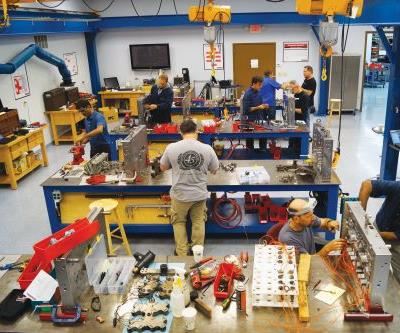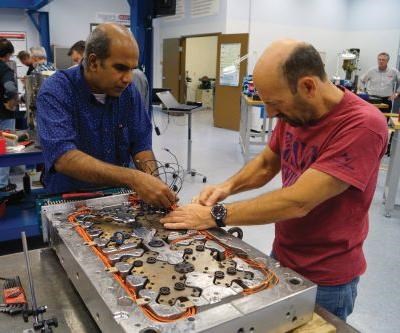Getting Started with Hot Runner Maintenance
Developing basic cleaning and repair skills among in-house technicians should be the goal of every shop that runs hot runner systems.
New technology for the design, manufacture and use of molds influences their reliability and performance, ultimately impacting part quality. It also means that molds are continuing to become more complicated and tedious to maintain and repair. This includes hot runner molds, whose use continues to grow, thanks to benefits such as reduced molding costs and improved design capabilities that make them attractive over cold runners. However, their mechanical and process wizardry comes with challenges—maintenance being the number one challenge. Someone has to keep these molds in good shape and perform repairs when they wear out or break—and they will wear out and break. Maybe not as a result of the design, but because people have the final say in how they are run and maintained.
In mold repair shops around the world, hot runner systems have the reputation of being “something we don’t mess with” when it’s time for in-house repair technicians to remove, clean, inspect and reassemble them. One little mistake like a loose bolt, pinched wire, brass shrapnel (from a hammer and other “soft” tool), using the wrong tool at the wrong time or applying the wrong amount of force can lead to catastrophic results. And that is just on the maintenance side of mold maintenance and repair. Failure to use proper start-up procedures can also have disastrous effects.
The fact is that manifolds and related components should not be that difficult to maintain and repair, considering the level of maintenance many repair technicians already perform daily on close-tolerance ejector systems, cores, cavities, spring-loaded slides, cams and other dynamic tooling configurations. Yet, although a technician must pay close attention in performing any type of close-tolerance mold work, there is a difference between maintenance and repair of mold components and that of hot runner molds. Making a mistake that causes a water or oil leak is usually not as disastrous as encapsulating a plate full of expensive wires, heaters, thermocouples and other delicate components in a plastic cocoon. The skill required isn’t necessarily more demanding, but the consequences of mistakes are much less forgiving.
Working on anything mechanical requires precise attention to details. This includes regularly documenting procedures and issues, understanding the critical-to-function areas, practicing patience, and maintaining focus throughout the process. For hot runner manifolds, danger lurks beyond the maintenance side of things. You can do everything right in the shop, then send it out to the press where a process technician who doesn’t appreciate the sealing power of a good 45-minute heat soaking ruins perfectly executed preventive maintenance (PM) on a mold.
Bringing it In House
In-house manifold maintenance and repair, and keeping hot runner systems healthy are two causes worthy of proper training. Any time a company can do anything in house, it usually results in faster and more cost-efficient work. In-house repairs are no exception. Avoiding having to crate up the mold and ship it out, then wait for the work to be completed and the mold to be returned allows a shop to stay on schedule. As an added benefit, the in-house maintenance team will appreciate not having a “limit” placed on their skills and development potential, improving bench confidence, motivation, professionalism and pay grade.
Here is a breakdown of some of the work involved in cleaning and repairing a manifold within a typical hot runner system:
• Map out systems (ohmmeter) for position verification of thermocouples and heaters.
• Perform heater resistance and connectivity checks and replacement.
• Verify correct thermocouple operation/location and replacement.
• Route (to connectors) and splice wires correctly.
• Disassemble and clean valve gates (valve pins, seals and cylinder components).
• Inspect and verify tooling conditions, and check manifold stack dimensions for proper preload.
• Perform comparative (cavity-to-cavity) dimensional analysis on nozzle and gate tip heights.
• Remove, clean and reinstall fixed (thermal) gate tips (sometimes done in the press).
The only practice for hot runner maintenance and repair that could be classified as a “non-standard” procedure is cleaning of internal manifold and nozzle channels by hot sand bath using fluid bed thermal process equipment. However, even these types of systems are readily available for those companies that frequently require this type of service and have room for it.
Many repair technicians today still lack the exposure and confidence to take a mold, strip the hot runner system down to the bare bones, inspect and replace components, and re-wire. However, this work is entirely within their skill set. All they truly lack is a basic understanding of the system and a documentation method that allows the critical elements of the process to be recorded. This is where proper training comes into play. It’s up to the company to provide that training and then continue to feed the employees manifold work that gradually increases in its degree of difficulty, growing their skills and confidence. It’s a win for all involved.
The steps to learning about runner systems are simple. First, technicians need to be educated in basic manifold information, such as plastic flow, seal types and expansion issues. Then they should learn about fixed-gate and valve-pin operation, and the critical elements that should be monitored. Next, they need to how to use an ohmmeter to map out a system and check for heater connectivity and resistance. This step also includes becoming knowledgeable on thermocouple types and basic wiring configurations (since every system is not conducive to heater replacement every time, proper wire splicing should not be overlooked). This is followed by getting a grasp on basic controller usage, and cable and connector issues. Bench safety concerns should also be discussed.
Basically, techs need to learn how to think through the process of maintaining a hot runner system. They need to understand the effect that temperature has on hot runner components, and the resultant impact on the timing and method of disassembly without causing damage. Blindly diving into a manifold teardown without first completing the proper homework is an invitation for trouble.
Working on hot runner manifolds and components requires a systematic approach in which everyone in the shop is trained on proper techniques and tools to keep hot runner systems functioning reliably and efficiently.
Related Content
Think Safety: Eliminate Hazards Throughout the Shop
The tooling community is taking advantage of new products for safer mold shops and molding facilities.
Read MoreWhat You Need to Know About Hot Runner Systems and How to Optimize Their Performance
How to make the most out of the hot runner design, function and performance.
Read MoreWhat is Scientific Maintenance? Part 2
Part two of this three-part series explains specific data that toolrooms must collect, analyze and use to truly advance to a scientific maintenance culture where you can measure real data and drive decisions.
Read MoreLaser Welding Versus Micro Welding
The latest battle in finely detailed restoration/repair of mold materials.
Read MoreRead Next
How to Use Continuing Education to Remain Competitive in Moldmaking
Continued training helps moldmakers make tooling decisions and properly use the latest cutting tool to efficiently machine high-quality molds.
Read MoreHow to Use Strategic Planning Tools, Data to Manage the Human Side of Business
Q&A with Marion Wells, MMT EAB member and founder of Human Asset Management.
Read More




















